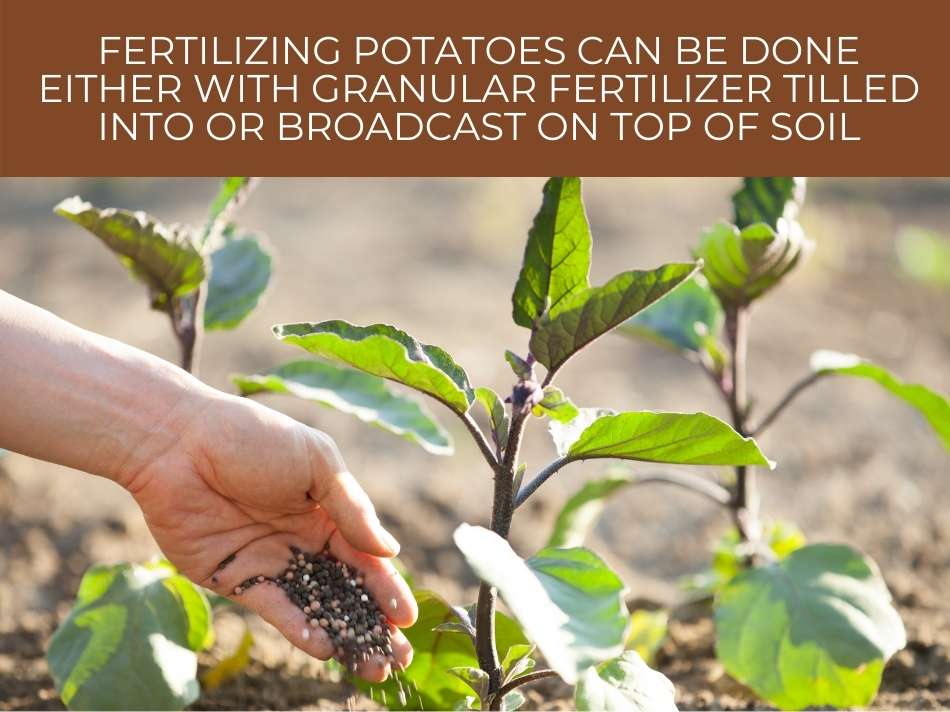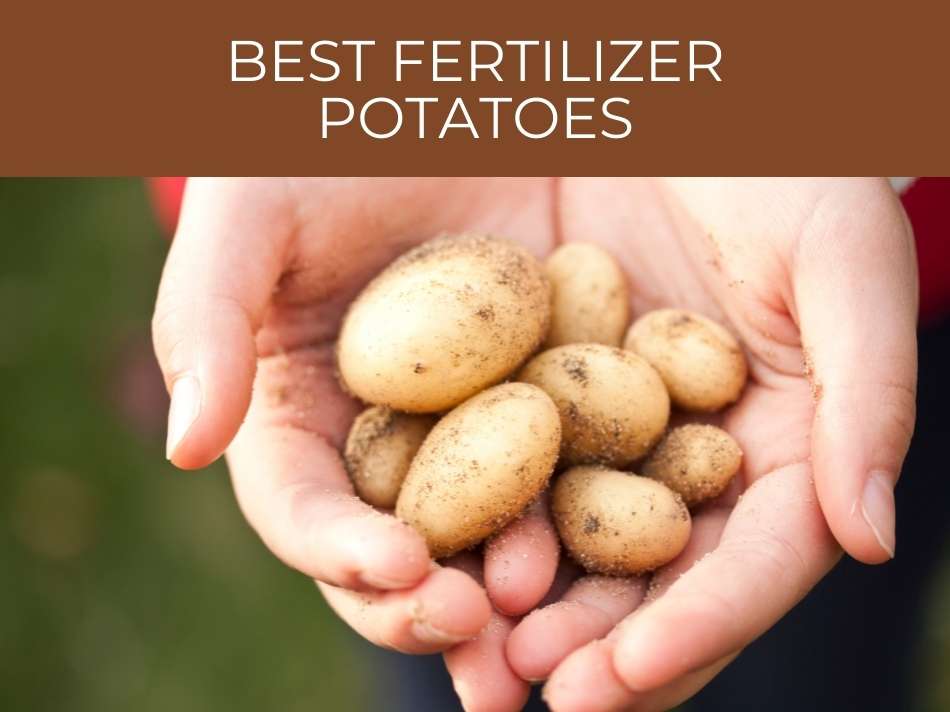A plot of land used over and over for a garden, or a crop of any kind, will lose its nutrients over time. Before there was fertilization, people would let fields take a year off to allow the soil to replenish itself. Today we have better options and a better understanding of how plants work.
Potatoes are heavy feeders which require slightly acidic soil pH between 5.5 – 6.5. Potatoes require high levels of nitrogen, phosphorus, & potassium to grow the best possible crop. Applying just the right amount at the right time will give the best yields regardless of the variety of potatoes.
Potatoes are relatively easy to grow and are considered low maintenance. However, the plants themselves require a lot of nutrients and will need to be fertilized more than once.

Best fertilizer potatoes
It would be a good idea to have your soil tested each year before you plant your crops.
This way you will know exactly what your soil needs.
The soil test can also show you the balance between the big three — potash (or potassium), phosphorous, and nitrogen — that you need.
Also, be cautious about using too much fertilizer, as too much can be even worse than not enough.

Fertilize potatoes soon after planting, & once a month until 2 – 3 weeks before harvest. The pH of the soil should be between 5.5 – 6.5. For most soils, use a fertilizer with N-P-K ratios of 1:1:1 or 1:2:2. Testing your soil will show which nutrients need to be added.
Potatoes grow best in lower temperatures.
There may not be much you can do about the weather, but keep it in mind when planting.
You cannot tell how your potatoes underground are doing, but generally, if your plants look healthy above ground, they will be in good shape below as well.
Another trick is to grow soybeans in the fall and dig them into the soil before planting.
This will add even more quality fertilizer to your potato crop.
See how far apart to plant potatoes.

Best fertilizer sweet potatoes
Sweet potatoes are a lot like regular potatoes and should be treated in a similar way.
Be careful about fertilizing too much too soon.
This can result in a lot of leaf and plant growth above ground at the expense of underground development.
The best environment is loose soil with organic matter.
Planting them at the proper depth also affects yield.
Commercial fertilizer comes in mixtures of the 3 big nutrients: nitrogen, potassium, & phosphorus. Formulas will be something like 5-10-10, 8-24-24. Soil tests can tell you which combination of nutrients is needed.
Too much fertilization can lead to a good-looking plant with not much under the ground.
Of course, not fertilizing enough will have bad-looking plants as well as a poor crop yield.

Sweet potatoes do not need to be fertilized when you plant them, but a few weeks later, they will need the first treatment.
Water, drainage, type of soil, and temperatures also have a big impact on your sweet potatoes.
See our complete guide to growing sweet potatoes.

When to fertilize potatoes
It might make sense to fertilize when you plant, but gardening experts say it is not necessary to do so for regular or sweet potatoes.
The timing can make a lot of difference in the overall health of your plants.
Follow the manufacturer’s guide on how much to use, but generally, one to one and a half pounds per 100 square feet will be what you need.

Fertilize potato plants about 2 weeks after planting. Potatoes have shallow roots & are heavy feeders, so use fertilizer with N-P-K ratios of 1:1:1 or 1:2:2. Fertilize potatoes monthly, following the directions of the fertilizer maker. Stop fertilizing 2 – 3 weeks before harvest.
A good rule of thumb is that potatoes should be fertilized with fertilizer with N-P-K ratios of 1:1:1 or 1:2:2.
Potatoes need nitrogen, but not too much, and they need it earlier in the process.
Too much is not good either.
The other two main nutrients should be added at the same time, though at the levels suggested by your soil tests.
You may need some other compounds if your soil tests show a need in another area.
See our guide for how deep to plant potatoes..

How to fertilize potatoes
There are several methods to fertilize your potatoes.
The important thing is to make sure the nutrients get into the ground where the actual tubers grow.
You may use organic or store-bought fertilizer.
Do what works best for you, just make sure you get the nutrients the plants need in the soil.

Fertilizing potatoes can be done either with granular fertilizer tilled into or broadcast on top of soil, or mixed in water and applied from an irrigation system. Fertilizer granules should not touch seed potatoes, otherwise, the seed potatoes will become dehydrated and/or die.
Water is a great way to fertilize your potatoes.
One trick is to spread bone meal on your potatoes, especially if you expect rain. If there is no rain, then water, and the nutrients will wash down to the plant.
You may also connect fertilization to the system you use to water your plants. Just mix the fertilizer with your water. You may also use granular fertilizer to spread in your garden.
There are different ways, but the more important consideration is making sure your plants get what they need.
Soil tests are your greatest ally and will tell you what you need.
Mixing the fertilizer with water makes a lot of sense because you need to water your plants anyway.
But make sure you don’t do too much. Too much water or too much fertilizer can do more harm than good.
Find out when to harvest potatoes.

Best organic fertilizer for potatoes
The debate continues on whether to use organics in your gardening.
Natural materials are better for growing natural things like plants.
Even so, the important thing is to get your plants the right nutrients at the right time, regardless of how that happens.
Best organic fertilizers for potatoes include: cottonseed meal, bone meal, & greensand, & kelp meal. These supply adequate ratios of nitrogen, potassium, & phosphorus, while maintaining optimal soil pH between 5.5 – 6.5.
You may buy organic compost at your favorite gardening store. You could also create your own composting operation in your garden.
There are several places to get compost. Mix that with soil, and use it on your potatoes.
Using some organic material is good for your plants even if you use commercial grade fertilizer as well.

Fertilizer for potatoes in containers
You can still grow potatoes and other vegetables, even if you do not have a yard or a place to grow plants.
You may use containers of many kinds, and some people use bags to grow potatoes.
As long as they get water, sunlight, and the nutrients they need, plants are pretty adaptable to where they are.
An all-purpose fertilizer is best for plants in containers or bags. Follow the directions carefully because it is easy to over-fertilize in a confined area. You may also use organic fertilizers (cottonseed meal, bone meal, & greensand, & kelp meal).
Growing potatoes in a container, or a bag, is a great way to grow them without taking up much space.
You may also consider hydroponics, which is growing in water without soil.
Plants don’t care how they get their nutrients, and if they have adequate sunlight, they will produce a good yield.

